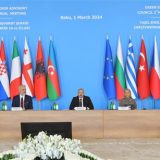The files we follow: Karabakh Conflict Resolution Process, Humanitarian and Security Update in Karabakh and the Lachin Corridor, Abkhazia and South Ossetia / Georgia Conflict, Georgia – EU/ US/Russia/Ukraine Relations and Georgian Domestic Policy, South Caucasian energy, trade and transport issues, Human Rights in South Caucasus, Various foreign policies Armenia, Azerbaijan, Georgia.
Consider subscribing for free access to the full content!
Last Sunday, President Ilham Aliyev visited different cities of Karabakh (Aghdara/Martakert; Khankendi/Stepanakert; Khodjali/Ivanian; Askeran; Khodjavend/Martouni) as well as the Sarsang reservoir, in which he raised the Azerbaijani flag each time and he gave a speech in the former separatist capital during which he recalled “There was a time when Azerbaijanis and Armenians lived here in a friendly atmosphere. There was a time when Azerbaijanis and Armenians lived in friendship not only in Khankendi but also in Karabakh, Baku, Ganja, Yerevan, Goycha, Zangezour, Daralayaz and Bazarkechar” while declaring: “The three clowns who sat here and called themselves “president” are now awaiting their deserved punishment. […] If certain Armenian forces are thinking of revenge, they should carefully examine these images.” In the former enclave, the Russian peacekeeping contingent announced on 18 October that “8 observation posts and 16 temporary observation posts [had been] removed since 19 September 2023 in the districts of Askeran, Mardakert, Martouni and Choucha”.
For his part, the Armenian leader went to Strasbourg where he gave a speech on 17 October to the European Parliament concluding with the words “Long live democracy!”, in which he highlighted the democratic path taken by his country and without which, according to him, Armenia “would have lost its independence and sovereignty” and he denounced Azerbaijani attempts at political destabilization on 12 June 2021, before the parliamentary elections, by “invading up to 4 kilometers deep the sovereign territory of Armenia in a 100 kilometer section of the border line”. He thus once again denounced the inaction of the CSTO and called for international aid “in budgetary form” in particular for the reception of Armenian refugees from Karabakh in the face of what he calls “ethnic cleansing”. But he also complained about the UN, the OSCE and the EU, none of which he said had “taken a relevant decision.” He renewed his requests to favour, unlike Azerbaijan, the principles of the Prague summit in October 2022, in which France participated:
– mutual recognition of the sovereignty, inviolability of borders and territorial integrity of Armenia (29,800 km2) and Azerbaijan (86,600 km2);
– urgent need to work on the delimitation of borders on the basis of the most recent maps of the General Staff of the USSR which were provided to the parties, which should also serve as a basis for the separation of forces, to the finalization of the peace treaty and the resolution of conflicts and all humanitarian issues;
– greater regional cooperation and the reopening of all borders, including that between Armenia and Turkey, as well as the opening of regional connectivity links based on full respect for the sovereignty and jurisdiction of countries, as well as on the principles of equality and reciprocity;
The Azerbaijani side insisted on recalling the same evening that it was it which had proposed the 5 principles of the peace treaty following the “44-day war” while the TASS agency relayed a high-ranking Russian source deeming the speech “irresponsible and provocative” and declaring: “Pashinian is taking giant steps on the path of Vladimir Zelensky.”
Following last week’s Iranian-Azerbaijani meetings, the special envoy of the Azerbaijani president, Elchin Amirbayov, commented on October 16 on the term “Zanguezour corridor” during an interview with the BBC in these terms: “We recognize that it is the sovereign territory of Armenia. But it is important for us to know how the other side will ensure the safety of traffic along the corridor,” arguing that Azerbaijan was ready, if Armenia delayed the process, to build a road passing through Iranian territory. Nikol Pashinian spoke before the European Parliament of an “Armenian crossroads” or a “crossroads of Peace”.
If the road project through Zanguezour / Siounik linking Azerbaijan to its exclave of Nakhitchevan is essential to this country, and can be beneficial to Armenia as well, while allowing Turkey to finally directly connect its territory to the Central Asia via the South Caucasus, several obstacles present themselves, despite the temporary calming of the relationship between Iran and Azerbaijan.
First, Iranian opposition to any expansion of Turkey’s influence and to its plan to connect Central Asia so easily, but above all Iranian opposition to the fruitful cooperation between Azerbaijan and Israel on its doorstep .
Furthermore, there is an unknown that should not be overlooked and which could tip the
Vous devez souscrire à un abonnement EurasiaPeace pour avoir accès au contenu - Prendre votre abonnement






